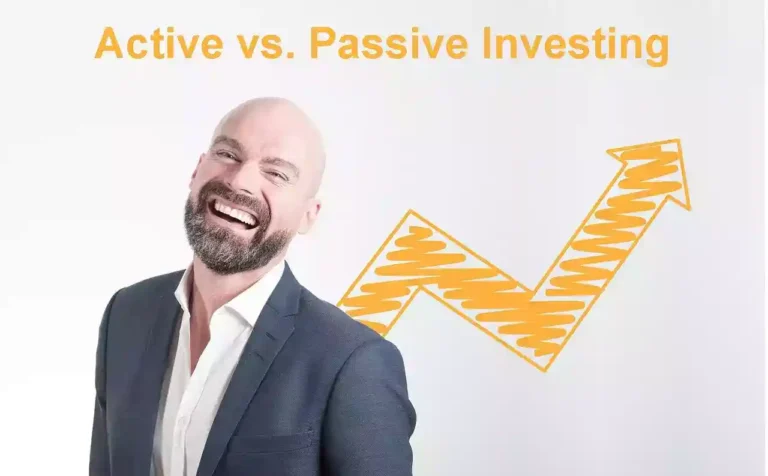“In the vast of investing, one debate captured the attention of professionals and individual investors: active vs. passive investing. Choosing the approach can have an impact on investment returns, understanding the nuances and of each strategy is.”
In this comprehensive guide, we will dive into the active vs passive investing debate. We explore the key differences these two approaches, they impact investors, and potential advantages and drawbacks of each Whether you are a investor or just starting, guide aims to provide with the knowledge to make informed investment.
Key Takeaways on Active vs. Passive Investing:
- Active vs. Passive Investing Decision: Your choice between active and passive investing depends on your risk tolerance, investment goals, and beliefs about market efficiency.
- Cost Matters: Active investing often comes with higher costs, which can eat into returns. Passive investing provides a cost-effective way to gain exposure to broad market movements.
- Realistic Performance Expectations: Active investing aims for outperformance, while passive investing aims to match market returns. Set realistic expectations and consider your comfort level with risk.
- Diversification is Key: Regardless of your approach, diversification helps manage risk. Active investors may diversify through various individual securities, while passive investors achieve it through exposure to an entire index.
Active Investing Taking Charge of Your Portfolio
Active investing involves a hands-on approach where fund managers and investors actively make decisions to buy and sell securities in an attempt to outperform the market. Proponents of Active Investing argue that it allows for greater flexibility and the potential to capitalize on short-term market fluctuations. Skilled fund managers leverage their expertise, research, and market analysis to make strategic investment decisions, with the goal of achieving returns that surpass benchmark indices.
However, Active Investing comes with its own set of challenges. The fees associated with active management can be higher, as investors pay for the expertise and time devoted to research. Additionally, the track record of consistently outperforming the market is a formidable task, as it requires accurately predicting market movements and staying ahead of the curve. Despite these challenges, Active Investing can be appealing for those seeking a more hands-on and potentially higher-reward strategy.
Digging Deeper: The Active Approach
Active investors actively buy and sell securities in an attempt to outperform the market. They rely on their skills, knowledge, and insights to capitalize on market inefficiencies, identify undervalued stocks, and seize lucrative opportunities.
The Professionals: Active Management
Many actively managed funds are led by professional portfolio managers who conduct in-depth research and analysis to make investment decisions on behalf of their clients. These managers strive to stay ahead of market trends and aim to outperform benchmark indexes.
The Pursuit of Alpha
Active investors constantly seek to generate alpha, which refers to returns that outperform a benchmark index. The pursuit of alpha involves actively analyzing financial statements, market data, and monitoring macroeconomic trends to identify investment opportunities that may outperform the broader market.
Key Characteristics of Active Investing:
- Hands-On Approach: Active investors take a proactive stance, constantly monitoring the market and adjusting their portfolios to capitalize on perceived opportunities or mitigate risks.
- Research-Driven: Successful active investing relies heavily on in-depth research and analysis. Investors often employ teams of analysts to identify undervalued stocks or emerging trends.
- Higher Costs: The hands-on nature of active investing incurs higher costs, including transaction fees, management fees, and research expenses. These costs can erode overall returns.
- Potential for Higher Returns: Proponents argue that active investing has the potential for higher returns, as skilled fund managers can exploit market inefficiencies and capitalize on short-term trends.
- Risk of Underperformance: On the flip side, active investing carries the risk of underperforming the market, especially when fees and expenses are taken into account. It requires accurate market timing and stock selection to outperform passive strategies consistently.
Advantages of Active Investing
- Flexibility and Control: Active investing allows individuals to make investment decisions aligned with their goals, risk tolerance, and market insights.
- Potential for Higher Returns: With diligent research and skillful execution, active investors have the potential to outperform the market and generate superior returns.
- Opportunity to Beat the Market: Active investors can take advantage of market inefficiencies and exploit mispriced securities to achieve above-average returns.
Drawbacks of Active Investing
- Higher Costs: Active investing typically incurs higher trading costs, such as transaction fees and brokerage commissions, which can eat into investment returns.
- Time and Effort: Active investing requires regular monitoring, research, and analysis, demanding significant time and skill. It can be challenging to consistently outperform the market over the long term.
- Potential for Underperformance: Active investing does not guarantee outperformance, and some actively managed funds may underperform their respective benchmark indexes.
Passive Investing: The Power of the Market
Passive Investing involves a more laid-back approach, where investors aim to replicate the performance of a specific market index or benchmark. Exchange-traded funds (ETFs) and index funds are common vehicles for Passive Investing, offering investors broad exposure to various asset classes. Advocates of Passive Investing highlight lower fees, reduced portfolio turnover, and the simplicity of maintaining a long-term investment strategy.
Passive Investing aligns with the philosophy that over the long term, the overall market tends to grow, and attempting to consistently beat the market is a challenging feat. By mirroring the market, investors can benefit from broad market trends without the need for constant portfolio adjustments. However, Passive Investors may experience the full impact of market downturns, as they do not actively make decisions to mitigate risks.
Passive investing, aims to mimic the performance of a given market index rather than actively selecting individual securities.
Passive investing has gained significant popularity in recent years, largely due to its simplicity and lower costs. Here are some key advantages of passive investing:
Understand Index Investing
Passive investors seek to replicate the performance of a specific market index, such as the Nifty 50 (India) or the S&P 500 (United States) or the FTSE 100 (United Kingdom). They achieve this by investing in index funds or exchange-traded funds (ETFs) that reflect the composition of the targeted index.
The Rise of Exchange-Traded Funds (ETFs)
ETFs have gained popularity among passive investors. These investment vehicles trade on stock exchanges, representing a basket of stocks or bonds that replicate the performance of a particular index. ETFs offer diversification, liquidity, and generally have lower expense ratios compared to mutual funds.
Key Characteristics of Active Investing:
- Low Cost: Passive investing typically incurs lower fees compared to active investing, as there is minimal trading and oversight involved.
- Long-Term Approach: It involves a buy-and-hold strategy, where investors seek to replicate the performance of the overall market over an extended period, often through index funds or ETFs.
- Minimized Portfolio Turnover: Passive investors aim to minimize buying and selling, which can lead to potentially superior after-tax results over the long term compared to active investing.
- Hands-Off Strategy: Passive investing is attractive to investors who prefer a more hands-off approach, as it does not seek to profit from short-term market fluctuations or timing.
Benefits of Passive Investing
- Diversification: Passive investing allows investors to gain exposure to a wide range of securities within an index, providing instant diversification across various sectors or asset classes.
- Lower Costs: Passive strategies generally have lower expense ratios compared to actively managed funds. Lower costs translate into more significant net returns for investors over the long term.
- Consistent Performance: Passive investors aim to match the performance of the target index, providing consistent and predictable returns over the long run.
Limitations of Passive Investing
- Limited Control: Passive investors do not have control over the individual securities held within the index fund or ETF. Any underperforming assets within the index will reflect in the overall performance.
- Missed Opportunities: Passive investors may miss out on potential gains that active investors can capture by actively selecting securities they believe will outperform the overall market.
- Market Risk: Passive investing exposes investors to market volatility, as the returns directly correlate with the performance of the underlying index. In bear markets, passive investments may experience significant declines.
Active vs. Passive Investing: Key Differences
| Feature | Active Investing | Passive Investing |
|---|---|---|
| Approach | Hands-on, seeks to outperform market | Hands-off, tracks an existing index |
| Investment selection | Individual securities chosen by fund manager | Basket of investments based on an index |
| Trading frequency | High, regular buying and selling | Low, minimal portfolio turnover |
| Management fees | Higher due to manager expertise | Lower due to automated tracking |
| Potential returns | Can potentially outperform market | Aims to match market performance |
| Risk | Higher due to individual security bets | Lower due to diversified exposure |
| Time commitment | High, requires research and monitoring | Low, “set-it-and-forget-it” approach |
| Emotional toll | Can be higher due to market fluctuations | Lower due to less active involvement |
| Skill level required | Generally higher, knowledge of markets needed | Lower, suitable for beginner investors |
The Active vs. Passive Investing Debate: Which Is Right for You?

When deciding between active and passive investing, there is no one-size-fits-all answer. Understanding your investment goals, risk appetite, time horizon, and personal preferences is crucial. Here are some key factors to consider:
Analyzing Your Goals and Preferences
Consider the level of involvement and control you desire over your investment portfolio. Are you comfortable delegating investment decisions to professionals, or do you prefer actively managing your investments?
Assessing Time and Resources
Active investing requires substantial time and effort. If you have limited time available for research, analysis, and monitoring the markets, a passive approach might be more suitable.
Risk Tolerance and Market Outlook
Evaluate your risk tolerance and outlook on market efficiency. If you believe in the ability to outperform the market or wish to actively respond to changing market conditions, active investing might align better with your investment philosophy.
The Role of Active and Passive Investing in a Portfolio
While active and passive investing are often presented as opposing strategies, they can also be complementary. Many investors choose to employ a hybrid approach, blending both active and passive strategies in their portfolios. Active strategies can be used to target specific opportunities or sectors, while passive strategies provide broad market exposure and diversification.
Factors to Consider in Active vs. Passive Investing
When deciding between active and passive investing, several factors should be taken into consideration:
1. Investment Goals and Time Horizon
Investors should assess their investment goals and time horizon. Passive investing may be more suitable for long-term investors seeking consistent returns and broad market exposure. Active investing may be appropriate for investors with a higher risk tolerance and a desire to pursue higher returns through active management.
2. Risk Tolerance
Risk tolerance plays a crucial role in determining the suitability of active or passive investing. Active investing typically involves higher volatility and the potential for greater losses. Passive investing, on the other hand, provides a more predictable and less risky approach.
3. Expertise and Resources
Active investing requires a certain level of expertise, research capabilities, and time commitment. Investors considering active investing should assess their ability to perform thorough research, monitor the market, and make informed investment decisions. Passive investing may be more suitable for investors who prefer a hands-off approach or lack the necessary expertise.
4. Costs and Fees
Investors should carefully consider the costs associated with both active and passive investing. Active management fees can be higher due to the additional research and management efforts involved. Passive investments generally have lower fees, which can lead to higher long-term returns.
5. Market Conditions
Market conditions and trends can also influence the decision between active and passive investing. Active strategies may be more effective in certain market environments, such as periods of high volatility or when specific sectors or assets are expected to outperform. Passive investing can be advantageous in more efficient and stable markets.
The decision between Active and Passive Investing ultimately depends on individual preferences, financial goals, and risk tolerance. Some investors may prefer the potential for higher returns associated with Active Investing, while others prioritize the stability and lower costs offered by Passive strategies.
It’s essential to consider factors such as investment horizon, market conditions, and personal comfort with risk. Many investors also adopt a hybrid approach, incorporating both Active and Passive strategies to create a well-balanced portfolio that aligns with their unique financial objectives.
Conclusion on Active vs. Passive Investing
Active and passive investing are two distinct approaches with their own set of advantages and considerations. While passive investing offers simplicity, lower costs, and market-matching returns, active investing provides the potential for outperformance, customization, and the opportunity to capitalize on market inefficiencies.
Ultimately, the choice between active and passive investing depends on individual preferences, investment goals, risk tolerance, and available resources. Some investors may prefer a purely active or passive approach, while others may choose to combine both strategies to achieve a balanced investment portfolio.
It’s important for investors to carefully evaluate their options, consider their unique circumstances, and seek professional advice if needed before making investment decisions. By understanding the differences between active and passive investing, investors can make informed choices that align with their financial goals and risk tolerance.
“Investing is not a one-size-fits-all endeavor. Take the time to understand your goals, evaluate your options, and tailor your approach accordingly. The right investment strategy can set you on the path to financial success.”
FAQs – Related to Active vs. Passive Investing
What is the difference between active and passive investing?
Active investing involves actively managing a portfolio by selecting individual securities and making decisions based on market conditions and analysis. Passive investing, on the other hand, seeks to mirror a particular index and track its performance, without actively trying to beat the market.
What are the pros and cons of active investing?
Active investing offers the potential to outperform the market and provides flexibility to navigate various market conditions. However, it comes with higher costs, increased risk, and the need for investment expertise.
What are the pros and cons of passive investing?
Passive investing is generally considered a lower-cost, lower-risk option that tracks a specific index. It is suitable for investors who prioritize long-term growth and do not want to actively manage their portfolio. However, it may not provide the potential for outperforming the market.
How do I choose between active and passive investing?
The choice between active and passive investing depends on factors such as your investment goals, level of expertise, risk tolerance, and cost considerations. It is essential to evaluate your personal circumstances and consult with a financial advisor before making a decision.
What is the debate over active and passive investing?
The debate over active and passive investing is ongoing, with proponents on both sides. Some argue that active management can provide better returns and flexibility, while others believe that passive investing is a more cost-effective and efficient strategy.
What is the role of a financial advisor in active and passive investing?
A financial advisor can help you evaluate your investment goals, risk tolerance, and expertise to determine whether active or passive investing is more suitable for your needs. They can also provide guidance on selecting the right investment strategies and products.

